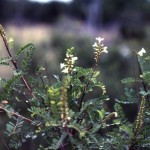Texas Kidneywood
Eysenhardtia texana Scheele
Fabaceae (Legume family)
Description
Texas Kidneywood is an evergreen shrub with slender gray stems that reach heights ranging from 3-8 feet or 0.9 to 2.4 m but can reach up to 10 ft or 3 m. It has multiple stems from the base and is irregularly shaped with an open and airy structure. Although it is in the same family as acacia and mimosa species, it does not have thorns. It has 15-47 tiny leaflets about 0.25 in or 0.6 cm long that form an alternately compounded leaf that measures up to 3.5 inches or 8.9 cm in length. Leaves are pungent when crushed. The tiny, hairy, white flowers emerge in 1 to 4 inch or 2.5 to 10 cm long clusters from April to November. The flowers have a delicate fragrance. Texas Kidneywood's fruit is a thick, dotted, green-to-brown legume and contains 2-4 seeds. Fruits are about 0.375 inches to 0.95 cm in length and typically have a threadlike tip. Seeds are kidney-shaped, slightly plump, and light to dark brown when mature. Texas Kidneywood is highly browsed by white-tailed deer and is also browsed by cattle and goats. Its seeds and flowers are valuable for insects and birds.Habitat
Texas Kidneywood is found throughout South Texas, more often in the northern portions. It prefers dry, calcareous soils and rocky limestone hills and canyons. Its native habitat includes brushy vegetation in the Rio Grande Plains, Central and West Texas. Drought-tolerant.Images
Plant Characteristics
Flower Color: White
Seed Type: Bean/Pod
Duration: Perennial
Stem Texture: Hairless/Smooth
Growth Habit: Shrub (Woody)
Leaf Shape
 : Pinnately Compound
: Pinnately Compound
Season: Evergreen
Distribution
 : 01 - Pineywoods, 02 - Gulf Prairies and Marshes, 03 - Post Oak Savannah, 04 - Blackland Prairies, 05 - Cross Timbers and Prairies, 06 - South Texas Plains, 07 - Edwards Plateau, 08 - Rolling Plains, 10 - Trans-Pecos
: 01 - Pineywoods, 02 - Gulf Prairies and Marshes, 03 - Post Oak Savannah, 04 - Blackland Prairies, 05 - Cross Timbers and Prairies, 06 - South Texas Plains, 07 - Edwards Plateau, 08 - Rolling Plains, 10 - Trans-Pecos
Distributions
Distribution refers to the ecological region in Texas that a plant has been found. You can also view a clickable map.
Collection: Brush and Weeds


